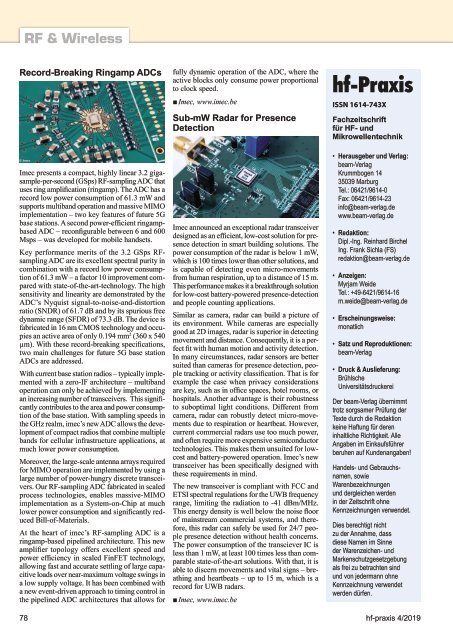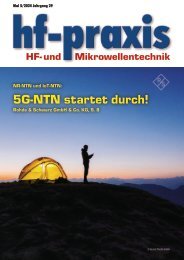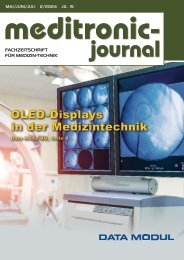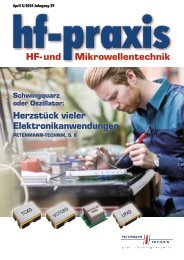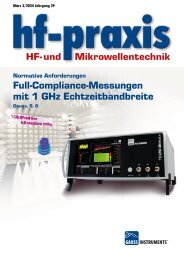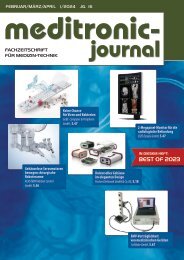4-2019
Fachzeitschrift für Hochfrequenz- und Mikrowellentechnik
Fachzeitschrift für Hochfrequenz- und Mikrowellentechnik
Erfolgreiche ePaper selbst erstellen
Machen Sie aus Ihren PDF Publikationen ein blätterbares Flipbook mit unserer einzigartigen Google optimierten e-Paper Software.
RF & Wireless<br />
Record-Breaking Ringamp ADCs<br />
Imec presents a compact, highly linear 3.2 gigasample-per-second<br />
(GSps) RF-sampling ADC that<br />
uses ring amplification (ringamp). The ADC has a<br />
record low power consumption of 61.3 mW and<br />
supports multiband operation and massive MIMO<br />
implementation – two key features of future 5G<br />
base stations. A second power-efficient ringampbased<br />
ADC – reconfigurable between 6 and 600<br />
Msps – was developed for mobile handsets.<br />
Key performance merits of the 3.2 GSps RFsampling<br />
ADC are its excellent spectral purity in<br />
combination with a record low power consumption<br />
of 61.3 mW – a factor 10 improvement compared<br />
with state-of-the-art-technology. The high<br />
sensitivity and linearity are demonstrated by the<br />
ADC’s Nyquist signal-to-noise-and-distortion<br />
ratio (SNDR) of 61.7 dB and by its spurious free<br />
dynamic range (SFDR) of 73.3 dB. The device is<br />
fabricated in 16 nm CMOS technology and occupies<br />
an active area of only 0.194 mm 2 (360 x 540<br />
µm). With these record-breaking specifications,<br />
two main challenges for future 5G base station<br />
ADCs are addressed.<br />
With current base station radios – typically implemented<br />
with a zero-IF architecture – multiband<br />
operation can only be achieved by implementing<br />
an increasing number of transceivers. This significantly<br />
contributes to the area and power consumption<br />
of the base station. With sampling speeds in<br />
the GHz realm, imec’s new ADC allows the development<br />
of compact radios that combine multiple<br />
bands for cellular infrastructure applications, at<br />
much lower power consumption.<br />
Moreover, the large-scale antenna arrays required<br />
for MIMO operation are implemented by using a<br />
large number of power-hungry discrete transceivers.<br />
Our RF-sampling ADC fabricated in scaled<br />
process technologies, enables massive-MIMO<br />
implementation as a System-on-Chip at much<br />
lower power consumption and significantly reduced<br />
Bill-of-Materials.<br />
At the heart of imec’s RF-sampling ADC is a<br />
ringamp-based pipelined architecture. This new<br />
amplifier topology offers excellent speed and<br />
power efficiency in scaled FinFET technology,<br />
allowing fast and accurate settling of large capacitive<br />
loads over near-maximum voltage swings in<br />
a low supply voltage. It has been combined with<br />
a new event-driven approach to timing control in<br />
the pipelined ADC architectures that allows for<br />
fully dynamic operation of the ADC, where the<br />
active blocks only consume power proportional<br />
to clock speed.<br />
■ Imec, www.imec.be<br />
Sub-mW Radar for Presence<br />
Detection<br />
Imec announced an exceptional radar transceiver<br />
designed as an efficient, low-cost solution for presence<br />
detection in smart building solutions. The<br />
power consumption of the radar is below 1 mW,<br />
which is 100 times lower than other solutions, and<br />
is capable of detecting even micro-movements<br />
from human respiration, up to a distance of 15 m.<br />
This performance makes it a breakthrough solution<br />
for low-cost battery-powered presence-detection<br />
and people counting applications.<br />
Similar as camera, radar can build a picture of<br />
its environment. While cameras are especially<br />
good at 2D images, radar is superior in detecting<br />
movement and distance. Consequently, it is a perfect<br />
fit with human motion and activity detection.<br />
In many circumstances, radar sensors are better<br />
suited than cameras for presence detection, people<br />
tracking or activity classification. That is for<br />
example the case when privacy considerations<br />
are key, such as in office spaces, hotel rooms, or<br />
hospitals. Another advantage is their robustness<br />
to suboptimal light conditions. Different from<br />
camera, radar can robustly detect micro-movements<br />
due to respiration or heartbeat. However,<br />
current commercial radars use too much power,<br />
and often require more expensive semiconductor<br />
technologies. This makes them unsuited for lowcost<br />
and battery-powered operation. Imec’s new<br />
transceiver has been specifically designed with<br />
these requirements in mind.<br />
The new transceiver is compliant with FCC and<br />
ETSI spectral regulations for the UWB frequency<br />
range, limiting the radiation to -41 dBm/MHz.<br />
This energy density is well below the noise floor<br />
of mainstream commercial systems, and therefore,<br />
this radar can safely be used for 24/7 people<br />
presence detection without health concerns.<br />
The power consumption of the transciever IC is<br />
less than 1 mW, at least 100 times less than comparable<br />
state-of-the-art solutions. With that, it is<br />
able to discern movements and vital signs – breathing<br />
and heartbeats – up to 15 m, which is a<br />
record for UWB radars.<br />
■ Imec, www.imec.be<br />
hf-Praxis<br />
ISSN 1614-743X<br />
Fachzeitschrift<br />
für HF- und<br />
Mikrowellentechnik<br />
• Herausgeber und Verlag:<br />
beam-Verlag<br />
Krummbogen 14<br />
35039 Marburg<br />
Tel.: 06421/9614-0<br />
Fax: 06421/9614-23<br />
info@beam-verlag.de<br />
www.beam-verlag.de<br />
• Redaktion:<br />
Dipl.-Ing. Reinhard Birchel<br />
Ing. Frank Sichla (FS)<br />
redaktion@beam-verlag.de<br />
• Anzeigen:<br />
Myrjam Weide<br />
Tel.: +49-6421/9614-16<br />
m.weide@beam-verlag.de<br />
• Erscheinungsweise:<br />
monatlich<br />
• Satz und Reproduktionen:<br />
beam-Verlag<br />
• Druck & Auslieferung:<br />
Brühlsche<br />
Universitätsdruckerei<br />
Der beam-Verlag übernimmt<br />
trotz sorgsamer Prüfung der<br />
Texte durch die Redaktion<br />
keine Haftung für deren<br />
inhaltliche Richtigkeit. Alle<br />
Angaben im Einkaufsführer<br />
beruhen auf Kundenangaben!<br />
Handels- und Gebrauchsnamen,<br />
sowie<br />
Warenbezeichnungen<br />
und dergleichen werden<br />
in der Zeitschrift ohne<br />
Kennzeichnungen verwendet.<br />
Dies berechtigt nicht<br />
zu der Annahme, dass<br />
diese Namen im Sinne<br />
der Warenzeichen- und<br />
Markenschutzgesetzgebung<br />
als frei zu betrachten sind<br />
und von jedermann ohne<br />
Kennzeichnung verwendet<br />
werden dürfen.<br />
78 hf-praxis 4/<strong>2019</strong>


